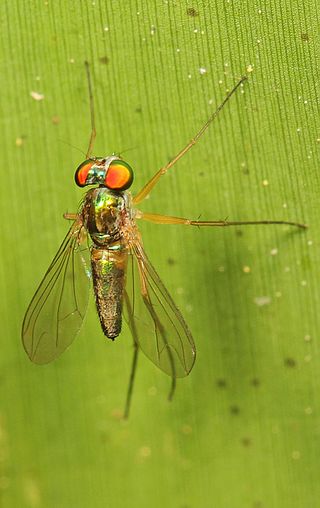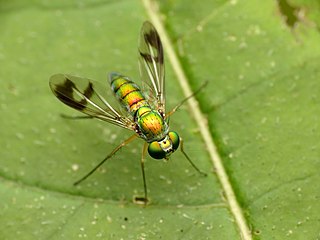Abbemyia is a genus of flies in the family Dolichopodidae, known from Australia and New Caledonia. It is named after the French entomologist Abbé Octave Parent, who studied the family Dolichopodidae.

Amblypsilopus is a genus of flies in the family Dolichopodidae. It is a large genus, with about 350 species recorded. However, it is possibly polyphyletic.
Bickelia is a genus of flies in the family Dolichopodidae. It is named after the Australian dipterologist Daniel J. Bickel.
Bickeliolus is a genus of flies in the family Dolichopodidae. It was originally a subgenus of Ethiosciapus, but was later raised to genus rank in 1998.

Chrysosoma is a genus of flies in the family Dolichopodidae. It is a large genus, with more than 200 species distributed in the Old World and Oceania.

Condylostylus is a genus of flies in the family Dolichopodidae. It is the second largest genus in the subfamily Sciapodinae, with more than 250 species included. It has a high diversity in the Neotropical realm, where 70% of the species occur.
Corindia is a genus of flies in the family Dolichopodidae. It is known mainly from the Afrotropical and Australasian realms, with a single species from the Palaearctic realm and an undescribed species also known from the Neotropical realm. The genus was first described in 1986 by Daniel J. Bickel, who originally considered it to be the sister group of the genus Thrypticus. Bickel later suggested that Corindia may represent a plesiomorphic and paraphlyetic assemblage from which Thrypticus arose.
Ethiosciapus is a genus of flies in the family Dolichopodidae.
Helixocerus is a genus of flies in the family Dolichopodidae. It is known from New Caledonia, American Samoa and Western Samoa.

Lichtwardtia is a genus of flies in the family Dolichopodidae. It is known from the Afrotropical, Oriental and Australasian realms. It can be recognised by its zigzag-shaped M vein on the wings, and its feather-like hairs on the apex segment of the antennae. In a phylogenetic analysis of the subfamily Dolichopodinae by Scott E. Brooks in 2005, Lichtwardtia is considered to be a synonym of Dolichopus, but subsequent authors have retained it as a valid genus.
Mesorhaga is a genus of flies in the family Dolichopodidae.

Parentia is a large genus of flies in the family Dolichopodidae.

Medeterinae is a subfamily of flies in the family Dolichopodidae.
Pindaia is a genus of fly in the family Dolichopodidae from the Australasian realm. The genus is named after the New Caledonian place name "Pindai".
Lapita is a genus of flies in the family Dolichopodidae. It is known from New Caledonia, Fiji and Vanuatu.

Sciapodini is a tribe of flies in the family Dolichopodidae.

Chrysosomatini is a tribe of flies in the family Dolichopodidae.
Pouebo symmetricauda is a species of fly belonging to the family Dolichopodidae. It is the only member of the genus Pouebo, and was described from New Caledonia.







